Question Number 123398 by bemath last updated on 25/Nov/20
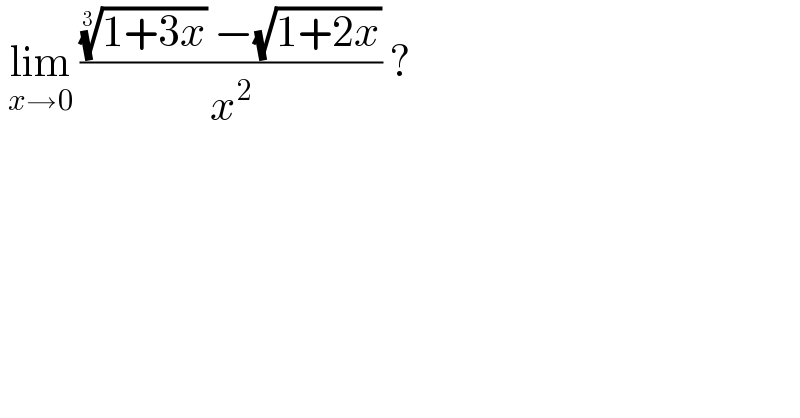
$$\:\underset{{x}\rightarrow\mathrm{0}} {\mathrm{lim}}\:\frac{\sqrt[{\mathrm{3}}]{\mathrm{1}+\mathrm{3}{x}}\:−\sqrt{\mathrm{1}+\mathrm{2}{x}}}{{x}^{\mathrm{2}} }\:? \\ $$
Answered by Dwaipayan Shikari last updated on 25/Nov/20
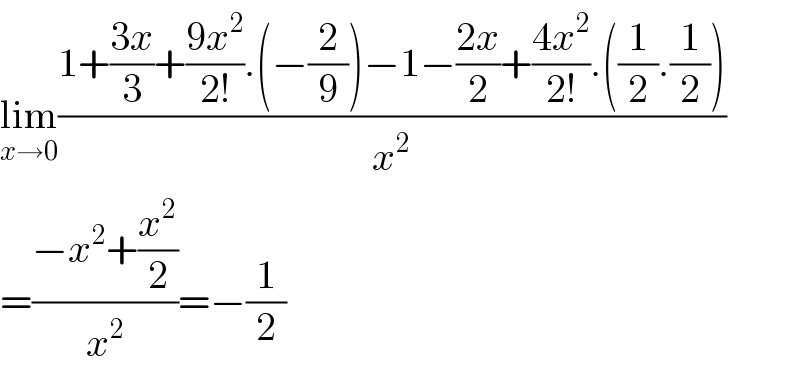
$$\underset{{x}\rightarrow\mathrm{0}} {\mathrm{lim}}\frac{\mathrm{1}+\frac{\mathrm{3}{x}}{\mathrm{3}}+\frac{\mathrm{9}{x}^{\mathrm{2}} }{\mathrm{2}!}.\left(−\frac{\mathrm{2}}{\mathrm{9}}\right)−\mathrm{1}−\frac{\mathrm{2}{x}}{\mathrm{2}}+\frac{\mathrm{4}{x}^{\mathrm{2}} }{\mathrm{2}!}.\left(\frac{\mathrm{1}}{\mathrm{2}}.\frac{\mathrm{1}}{\mathrm{2}}\right)}{{x}^{\mathrm{2}} } \\ $$$$=\frac{−{x}^{\mathrm{2}} +\frac{{x}^{\mathrm{2}} }{\mathrm{2}}}{{x}^{\mathrm{2}} }=−\frac{\mathrm{1}}{\mathrm{2}} \\ $$
Answered by TANMAY PANACEA last updated on 25/Nov/20
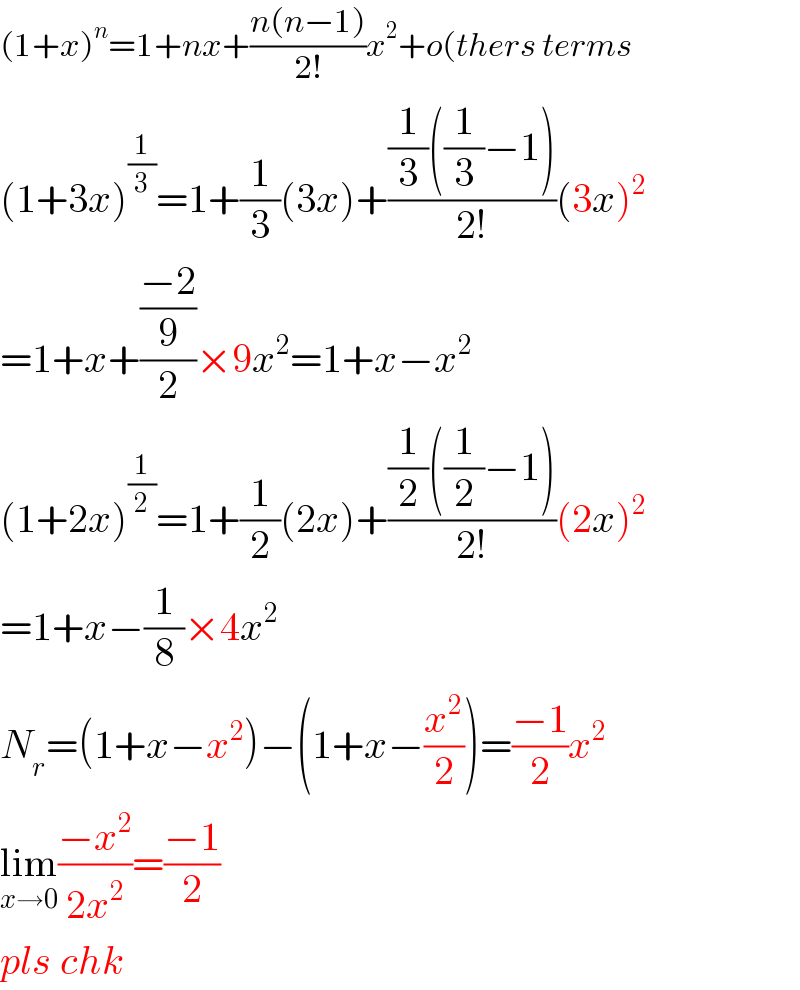
$$\left(\mathrm{1}+{x}\right)^{{n}} =\mathrm{1}+{nx}+\frac{{n}\left({n}−\mathrm{1}\right)}{\mathrm{2}!}{x}^{\mathrm{2}} +{o}\left({thers}\:{terms}\right. \\ $$$$\left(\mathrm{1}+\mathrm{3}{x}\right)^{\frac{\mathrm{1}}{\mathrm{3}}} =\mathrm{1}+\frac{\mathrm{1}}{\mathrm{3}}\left(\mathrm{3}{x}\right)+\frac{\frac{\mathrm{1}}{\mathrm{3}}\left(\frac{\mathrm{1}}{\mathrm{3}}−\mathrm{1}\right)}{\mathrm{2}!}\left(\mathrm{3}{x}\right)^{\mathrm{2}} \\ $$$$=\mathrm{1}+{x}+\frac{\frac{−\mathrm{2}}{\mathrm{9}}}{\mathrm{2}}×\mathrm{9}{x}^{\mathrm{2}} =\mathrm{1}+{x}−{x}^{\mathrm{2}} \\ $$$$\left(\mathrm{1}+\mathrm{2}{x}\right)^{\frac{\mathrm{1}}{\mathrm{2}}} =\mathrm{1}+\frac{\mathrm{1}}{\mathrm{2}}\left(\mathrm{2}{x}\right)+\frac{\frac{\mathrm{1}}{\mathrm{2}}\left(\frac{\mathrm{1}}{\mathrm{2}}−\mathrm{1}\right)}{\mathrm{2}!}\left(\mathrm{2}{x}\right)^{\mathrm{2}} \\ $$$$=\mathrm{1}+{x}−\frac{\mathrm{1}}{\mathrm{8}}×\mathrm{4}{x}^{\mathrm{2}} \\ $$$${N}_{{r}} =\left(\mathrm{1}+{x}−{x}^{\mathrm{2}} \right)−\left(\mathrm{1}+{x}−\frac{{x}^{\mathrm{2}} }{\mathrm{2}}\right)=\frac{−\mathrm{1}}{\mathrm{2}}{x}^{\mathrm{2}} \\ $$$$\underset{{x}\rightarrow\mathrm{0}} {\mathrm{lim}}\frac{−{x}^{\mathrm{2}} }{\mathrm{2}{x}^{\mathrm{2}} }=\frac{−\mathrm{1}}{\mathrm{2}} \\ $$$${pls}\:{chk} \\ $$
Answered by TANMAY PANACEA last updated on 25/Nov/20
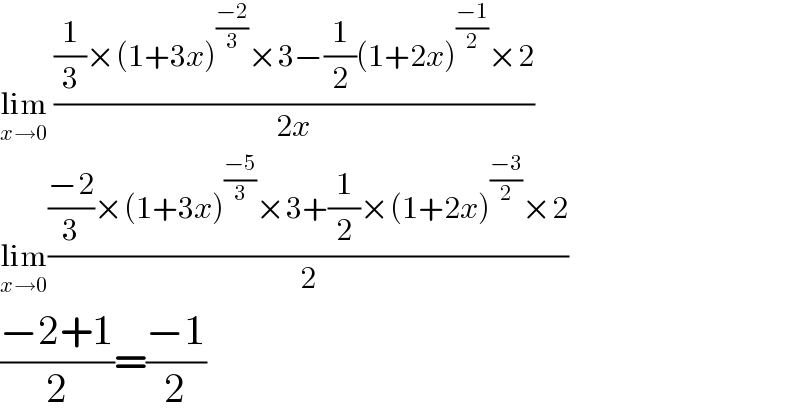
$$\underset{{x}\rightarrow\mathrm{0}} {\mathrm{lim}}\:\frac{\frac{\mathrm{1}}{\mathrm{3}}×\left(\mathrm{1}+\mathrm{3}{x}\right)^{\frac{−\mathrm{2}}{\mathrm{3}}} ×\mathrm{3}−\frac{\mathrm{1}}{\mathrm{2}}\left(\mathrm{1}+\mathrm{2}{x}\right)^{\frac{−\mathrm{1}}{\mathrm{2}}} ×\mathrm{2}}{\mathrm{2}{x}} \\ $$$$\underset{{x}\rightarrow\mathrm{0}} {\mathrm{lim}}\frac{\frac{−\mathrm{2}}{\mathrm{3}}×\left(\mathrm{1}+\mathrm{3}{x}\right)^{\frac{−\mathrm{5}}{\mathrm{3}}} ×\mathrm{3}+\frac{\mathrm{1}}{\mathrm{2}}×\left(\mathrm{1}+\mathrm{2}{x}\right)^{\frac{−\mathrm{3}}{\mathrm{2}}} ×\mathrm{2}}{\mathrm{2}} \\ $$$$\frac{−\mathrm{2}+\mathrm{1}}{\mathrm{2}}=\frac{−\mathrm{1}}{\mathrm{2}} \\ $$
Answered by liberty last updated on 25/Nov/20
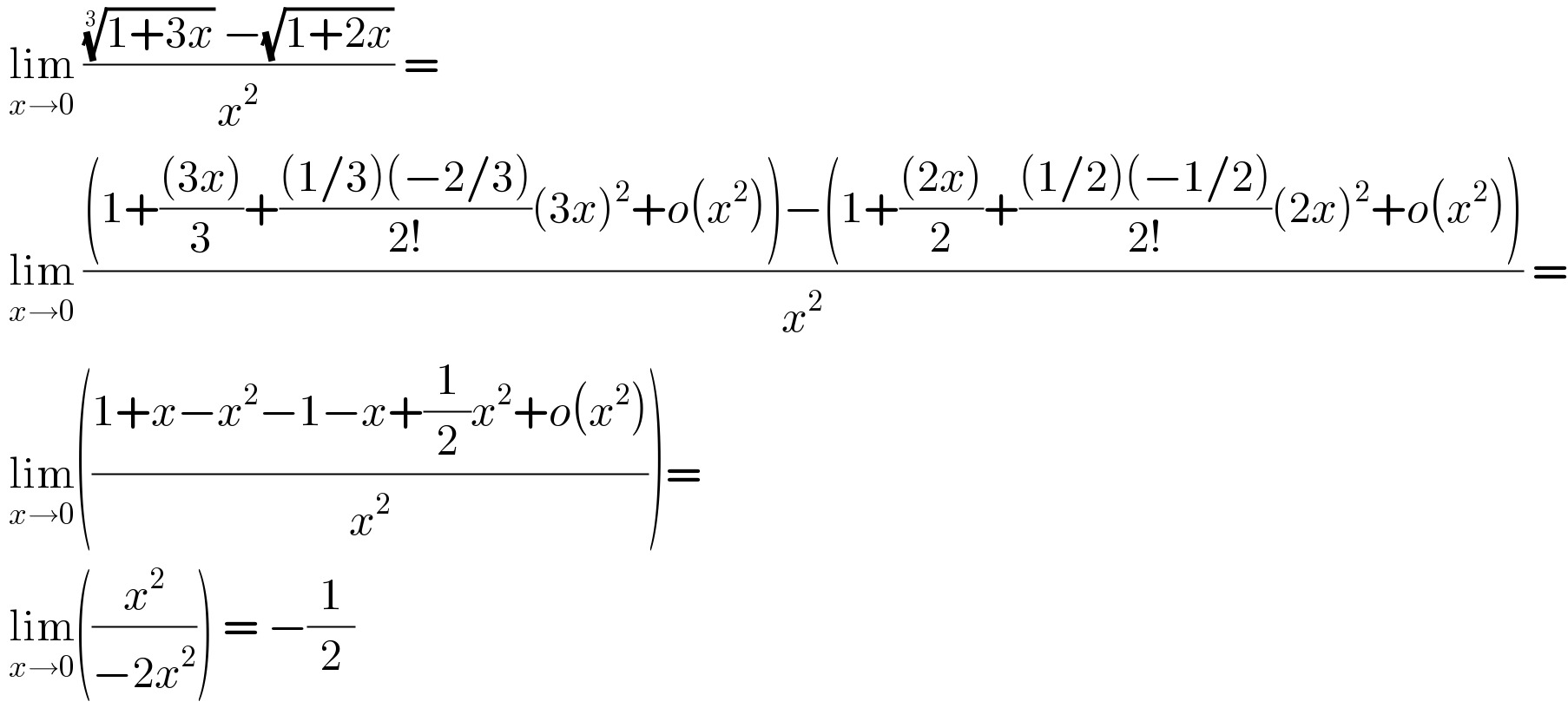
$$\:\underset{{x}\rightarrow\mathrm{0}} {\mathrm{lim}}\:\frac{\sqrt[{\mathrm{3}}]{\mathrm{1}+\mathrm{3}{x}}\:−\sqrt{\mathrm{1}+\mathrm{2}{x}}}{{x}^{\mathrm{2}} }\:=\: \\ $$$$\:\underset{{x}\rightarrow\mathrm{0}} {\mathrm{lim}}\:\frac{\left(\mathrm{1}+\frac{\left(\mathrm{3}{x}\right)}{\mathrm{3}}+\frac{\left(\mathrm{1}/\mathrm{3}\right)\left(−\mathrm{2}/\mathrm{3}\right)}{\mathrm{2}!}\left(\mathrm{3}{x}\right)^{\mathrm{2}} +{o}\left({x}^{\mathrm{2}} \right)\right)−\left(\mathrm{1}+\frac{\left(\mathrm{2}{x}\right)}{\mathrm{2}}+\frac{\left(\mathrm{1}/\mathrm{2}\right)\left(−\mathrm{1}/\mathrm{2}\right)}{\mathrm{2}!}\left(\mathrm{2}{x}\right)^{\mathrm{2}} +{o}\left({x}^{\mathrm{2}} \right)\right)}{{x}^{\mathrm{2}} }\:= \\ $$$$\:\underset{{x}\rightarrow\mathrm{0}} {\mathrm{lim}}\left(\frac{\mathrm{1}+{x}−{x}^{\mathrm{2}} −\mathrm{1}−{x}+\frac{\mathrm{1}}{\mathrm{2}}{x}^{\mathrm{2}} +{o}\left({x}^{\mathrm{2}} \right)}{{x}^{\mathrm{2}} }\right)= \\ $$$$\:\underset{{x}\rightarrow\mathrm{0}} {\mathrm{lim}}\left(\frac{{x}^{\mathrm{2}} }{−\mathrm{2}{x}^{\mathrm{2}} }\right)\:=\:−\frac{\mathrm{1}}{\mathrm{2}} \\ $$
Answered by Bird last updated on 25/Nov/20
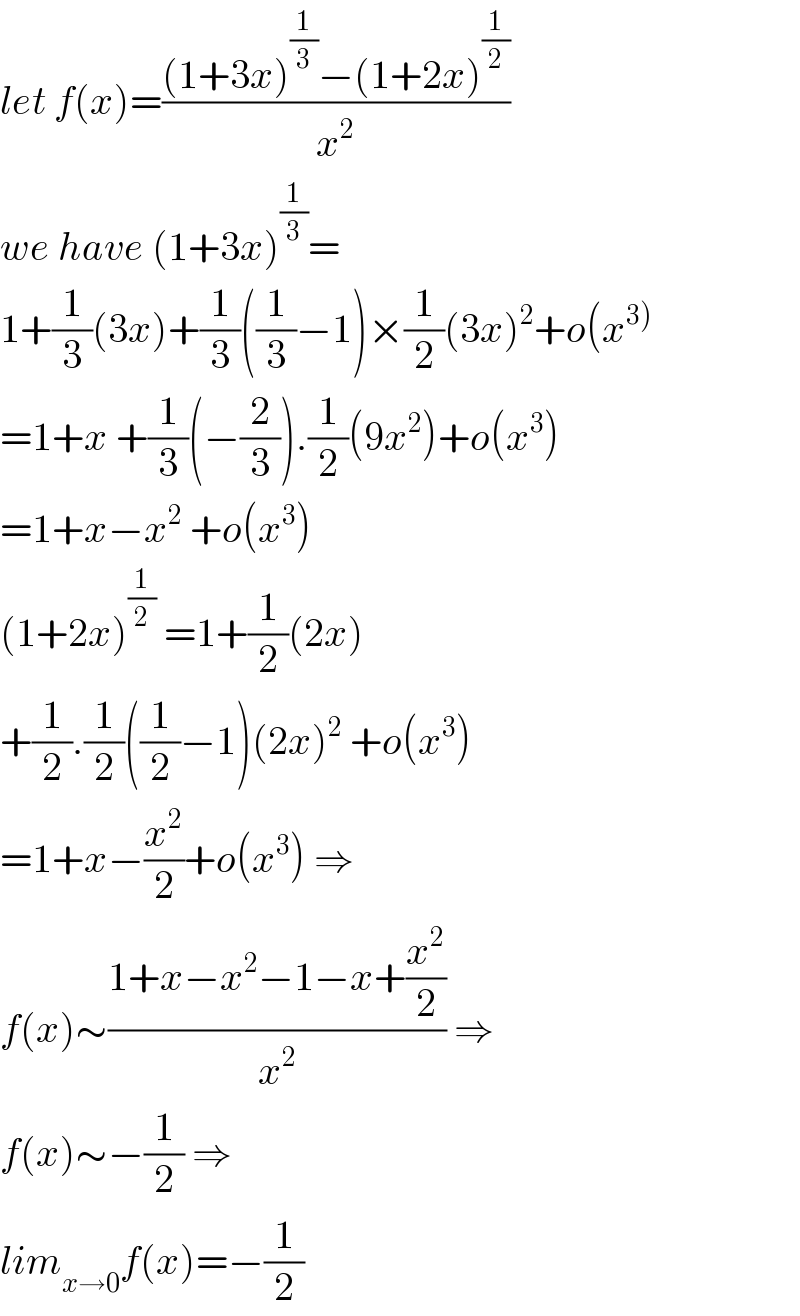
$${let}\:{f}\left({x}\right)=\frac{\left(\mathrm{1}+\mathrm{3}{x}\right)^{\frac{\mathrm{1}}{\mathrm{3}}} −\left(\mathrm{1}+\mathrm{2}{x}\right)^{\frac{\mathrm{1}}{\mathrm{2}}} }{{x}^{\mathrm{2}} } \\ $$$${we}\:{have}\:\left(\mathrm{1}+\mathrm{3}{x}\right)^{\frac{\mathrm{1}}{\mathrm{3}}} = \\ $$$$\mathrm{1}+\frac{\mathrm{1}}{\mathrm{3}}\left(\mathrm{3}{x}\right)+\frac{\mathrm{1}}{\mathrm{3}}\left(\frac{\mathrm{1}}{\mathrm{3}}−\mathrm{1}\right)×\frac{\mathrm{1}}{\mathrm{2}}\left(\mathrm{3}{x}\right)^{\mathrm{2}} +{o}\left({x}^{\left.\mathrm{3}\right)} \right. \\ $$$$=\mathrm{1}+{x}\:+\frac{\mathrm{1}}{\mathrm{3}}\left(−\frac{\mathrm{2}}{\mathrm{3}}\right).\frac{\mathrm{1}}{\mathrm{2}}\left(\mathrm{9}{x}^{\mathrm{2}} \right)+{o}\left({x}^{\mathrm{3}} \right) \\ $$$$=\mathrm{1}+{x}−{x}^{\mathrm{2}} \:+{o}\left({x}^{\mathrm{3}} \right) \\ $$$$\left(\mathrm{1}+\mathrm{2}{x}\right)^{\frac{\mathrm{1}}{\mathrm{2}}} \:=\mathrm{1}+\frac{\mathrm{1}}{\mathrm{2}}\left(\mathrm{2}{x}\right) \\ $$$$+\frac{\mathrm{1}}{\mathrm{2}}.\frac{\mathrm{1}}{\mathrm{2}}\left(\frac{\mathrm{1}}{\mathrm{2}}−\mathrm{1}\right)\left(\mathrm{2}{x}\right)^{\mathrm{2}} \:+{o}\left({x}^{\mathrm{3}} \right) \\ $$$$=\mathrm{1}+{x}−\frac{{x}^{\mathrm{2}} }{\mathrm{2}}+{o}\left({x}^{\mathrm{3}} \right)\:\Rightarrow \\ $$$${f}\left({x}\right)\sim\frac{\mathrm{1}+{x}−{x}^{\mathrm{2}} −\mathrm{1}−{x}+\frac{{x}^{\mathrm{2}} }{\mathrm{2}}}{{x}^{\mathrm{2}} }\:\Rightarrow \\ $$$${f}\left({x}\right)\sim−\frac{\mathrm{1}}{\mathrm{2}}\:\Rightarrow \\ $$$${lim}_{{x}\rightarrow\mathrm{0}} {f}\left({x}\right)=−\frac{\mathrm{1}}{\mathrm{2}} \\ $$
